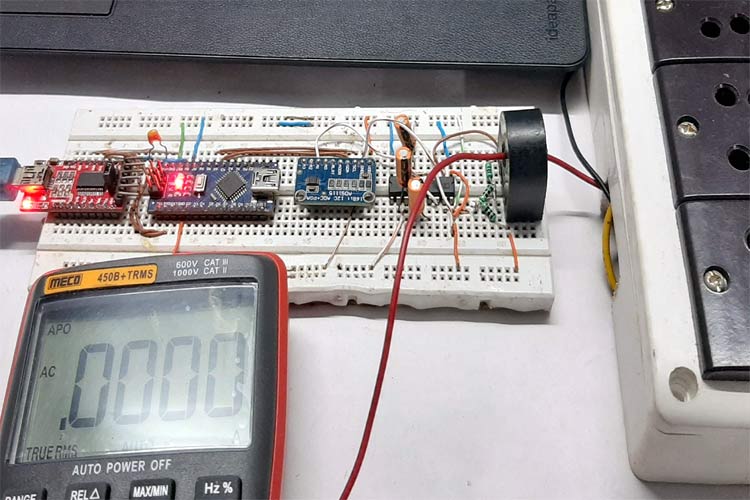
From large power stations to compact SMPS circuits, transformers can be found almost everywhere. Though there are many types of transformers and their exact working differs based on the application, the basic working of the Transformer remains the same. When examining transformer circuit schematics, you'll notice "dot" symbols placed on transformer windings. These dots follow the transformer dot convention - a critical polarity marking system. But what does the dot on a transformer mean, and how does this dot convention transformer circuit notation work in practice?
Table of Contents
What is the Dot Convention in Transformers?
The Dot convention is a type of polarity marking for transformer windings showing which end of the winding is which, concerning the other windings. It is used to indicate phase relationships in transformer schematic diagrams, involving the placement of dots on top of the primary and secondary terminals, as shown below.

Transformer Dot Convention Example: In-Phase Configuration
When the dots are placed next to the top ends of the primary and secondary windings as shown below, it indicates that the polarity of the instantaneous voltage across the primary winding will be the same as that across the secondary winding. Meaning the phase shift between the primary and secondary winding will be zero (in-phase), and the direction of the Secondary current (Is) and Primary current (Ip) will be the same.

Out-of-Phase Dot Convention Example
However, if the dots are placed in reversed positions (e.g. up on primary, down on secondary or vice versa), like the image below, It indicates that the primary and secondary current and voltages are 180° out of phase and the primary and secondary currents (IP and IS) will be in opposite in direction to one another.

With the knowledge of this convention and the polarity of the transformer, the engineers now have their destiny in their hands and can decide to reverse the phase relationships in whichever way they want by changing which end of their circuit is connected to the transformer’s terminals. For instance, for the out-of-phase transformer example above, by switching how the terminals are connected, like the image below, the secondary side is made in-phase with the primary.

Why is the Transformer Dot Convention Critical in Electrical Systems?
In the study of transformers, it is generally assumed (at least for resistive loads) that the Voltage and Current are in phase for the secondary and primary windings. This assumption is usually based on the belief that the secondary winding and the primary winding of the transformer are done in the same direction. The phase relation between primary and secondary currents and voltages depends on how each winding is wrapped around the core; hence, if the winding is wrapped around the core in the same direction as shown below, then the voltage and current on both sides should be in phase. The transformer dot convention is useful in avoiding expensive consequences in electrical installations. The most serious error that can happen in an electrical installation when using transformers is to have incorrectly connected transformer windings or phases. If a properly polarised transformer is connected incorrectly, the result will be a loss of phase, effortlessly introducing system failures. This is of utmost importance when dealing with the current transformer dot convention in protection systems, as it leads to a field of voltage as zero and the associated protective relay will end up being either disabled or providing incorrect readings!... How do we protect against this occurring?

Current Transformer Dot Convention Applications
However, this assumption is not always correct, as the direction of the windings could be opposite (as shown in the image above), which will mean if connection is to the same terminals, then the voltage in the secondary winding (VS) will be out-of-phase and the direction of the current (Is) is in opposite direction to the primary current.
In current transformer dot convention applications, the polarity markings serve the essential purpose of having accurate power measurements and allowing the protection system to operate at the desired level. Properly identifying the polarity of the windings of transformers can make the difference between positive or negative power factor, to accurate instead of inaccurate cumulative energy readings, to the protection relay being enabled or disabled! The established convention will allow polarities to be identified for practical use.
This phase loss, and inverse polarity, however trivial it sounds, creates serious problems in power system protection, measurement, and control systems. As an example, reversing the polarity in an instrument transformer winding, for instance, may defeat protective relays, lead to inaccurate power and energy measurements, or result in the display of negative power factor during measurements. It could also lead to an effective short circuit in parallel transformer windings, and in signal circuits, can lead to incorrect operation of amplifiers and speaker systems, or cancellation of signals that are meant to add.
Since transformers are not transparent, it is impossible to know which way to connect a circuit to it to get an in-phase (or out-of-phase) voltage and current, thus, to mitigate the risks associated with reverse polarity connection and phase loss, and provide a way of identifying the polarity of the windings, transformer manufacturers came up with a polarity indication standard called; the “Dot Convention”.
Alphanumeric Labels in Transformers
Aside from the dot convention, another polarity indication technique used in transformers is the Alphanumeric labels, which are typically made up of the “H” and “X” along with subscript numbers which represent winding polarity. The “1” wires (H1 and X1) represent where the polarity-marking dots would normally be placed. A typical transformer with the alphanumeric label is shown below.

Frequently Asked Questions on Transformer Dot Convention
⇥ What does the dot on a transformer mean?
The dot on a transformer shows polarity marking, which indicates which terminals have the same instantaneous voltage polarity. The transformer dot convention system allows engineers to determine phase relations between primary and secondary windings.
⇥ How do you read the transformer dot convention?
Reading the transformer dot convention involves understanding a dot's position about the phase relationships. When revisiting a transformer schematic, look for the dot's position on the primary and secondary windings.
⇥ Why is the dot convention important in current transformers?
The current transformer dot convention is essential for the protection of the power system and accurate measurements. In electrical substations, current transformers supply protection relays and meters with reduced current signals. If the polarity is wrong, protection relays could have mis-operation or not operate on faults, leading to equipment damage or safety concerns.
⇥ What is the difference between the dot convention and H-X designators?
The dot convention for transformers simply uses dots to indicate polarity, while H-X labeling utilises alphanumeric designations for terminal identification. In H-X systems, "H" indicates high-voltage windings and "X" identifies low-voltage windings. The numbers identify the polarity relationship of the terminals. The H1 and x1 will also correspond to the dot markings in the dot convention; H markings would positively correspond to x markings to indicate equal polarities.
⇥ What are the implications of ignoring the transformer dot convention?
Ignoring the transformer dot convention could lead to very serious consequences for electrical systems. In the context of power applications, incorrect connections could lead to short circuit issues when parallel transformers are connected when opposite in polarity are connected. Consequential equipment damage could be incurred and present an operational safety concern for the operator.
This content has been reviewed for technical accuracy by practising electrical engineers and aligns with industry standards. If you have any doubts related to this article, then feel free to ask them in the comment section given below or visit our forum for more discussions.
Explore Transformer Concepts and Practical Builds
Advance your skills with a blend of foundational transformer theory and hands-on applications. Dive into essential concepts like dot convention and protection techniques, while also getting practical with real-world projects such as AC current sensing using current transformers and step-by-step transformer design for SMPS circuits.
All About Transformer Protection and Transformer Protection Circuits
In this article we will talk about the most common principles used to protect transformers from catastrophic failures.
AC Current Measurement using Current Transformer and Arduino
In this article we will learn current sensing technique in detail and wire up a current transformer to measure AC current with the help of an Arduino.
How to Design Transformer for SMPS Power Supply Circuits
Designing an efficient Power Supply circuit is not less of a challenge. Those who have already worked with SMPS circuits would easily agree that the flyback transformer design plays a vital role in designing an efficient power supply circuit.








